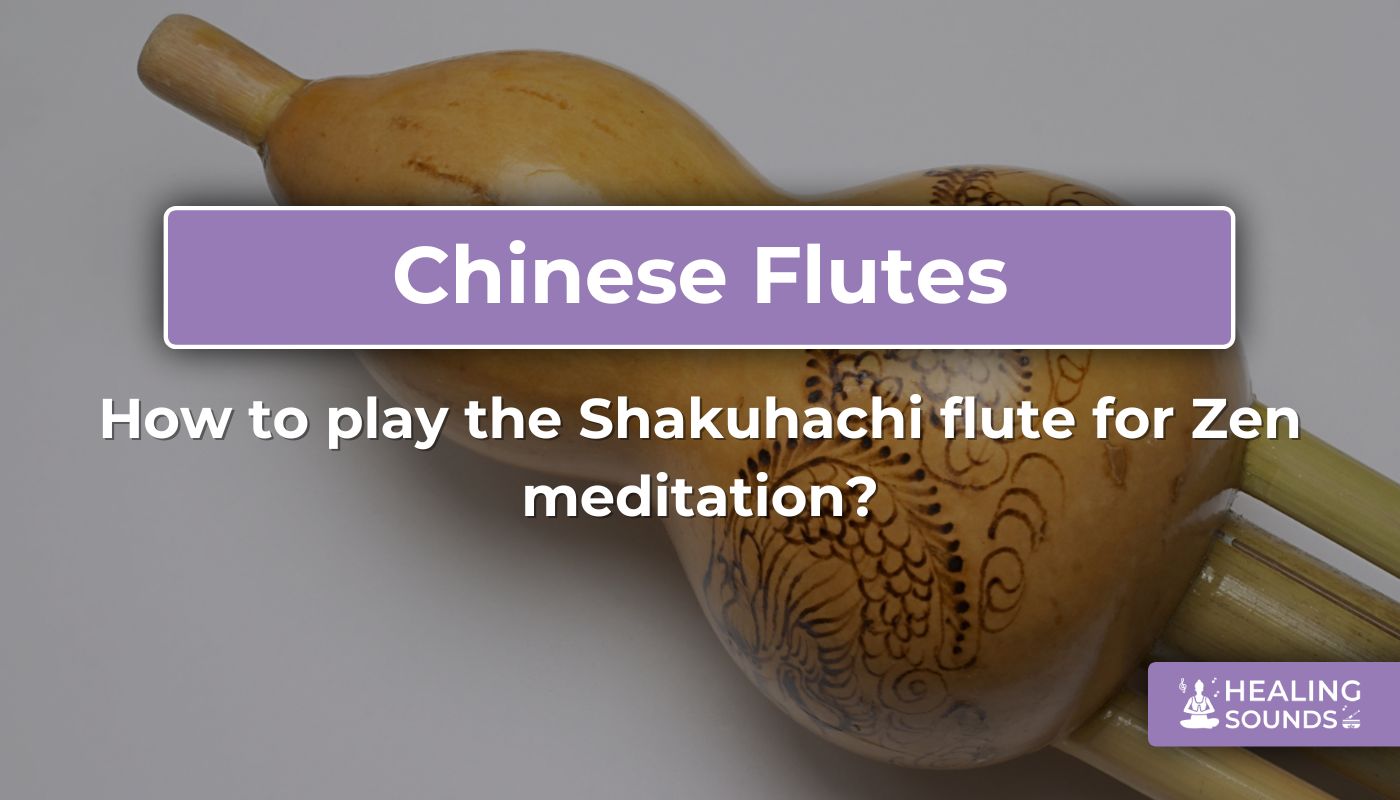Die Shakuhachi-Flöte mit ihren tiefen, hauchigen Tönen ist weit mehr als nur ein Musikinstrument. Sie ist ein Weg zu innerem Frieden und ein geschätztes Hilfsmittel in der Zen-Meditation . Seit Jahrhunderten verwenden Zen-buddhistische Mönche diese einfache Bambusflöte für „Suizen“ oder „Zen blasen“, eine Praxis der Achtsamkeit durch Klang. Wenn Sie sich zur Meditation, Achtsamkeit oder den ruhigen Klängen traditioneller japanischer Musik hingezogen fühlen, kann das Erlernen des Shakuhachi-Spiels eine äußerst lohnende Reise sein. Dieser Leitfaden führt Sie durch das Verständnis des Instruments, seiner Verbindung zum Zen, der Vorteile des Spielens und der wesentlichen Schritte, um Ihre eigene Meditationspraxis mit der Shakuhachi-Flöte zu beginnen.
Was ist die Shakuhachi-Flöte und welche Rolle spielt sie in der Zen-Meditation?
Die Shakuhachi-Flöte stammt ursprünglich aus China und wurde im 8. Jahrhundert in Japan eingeführt. Sie wird traditionell aus dem Wurzelende eines Bambusstamms gefertigt. Ihr schlichtes Design mit typischerweise fünf Grifflöchern täuscht über ihre komplexen Klangeigenschaften und ihre tiefe spirituelle Bedeutung hinweg. Sie ist untrennbar mit der Fuke-Sekte des Zen-Buddhismus verbunden, wo Mönche, bekannt als Komusō („Mönche der Leere und des Nichts“), sie nicht zur Unterhaltung, sondern als spirituelle Disziplin nutzten.
Das Spielen der Shakuhachi wurde selbst zu einer Form der Meditation – Suizen . Die Konzentration auf Atemkontrolle, Körperhaltung und Klangerzeugung hilft den Übenden, einen Zustand der Achtsamkeit zu erreichen und den physischen Akt des Spielens mit spiritueller Bewusstheit zu verbinden. Daher wird die Shakuhachi oft als Zen-Instrument schlechthin bezeichnet, das durch seinen resonanten Klang die Prinzipien von Einfachheit, Natur und Vergänglichkeit verkörpert.
Warum sollte man zur Zen-Meditation die Shakuhachi-Flöte spielen?
Die Integration der Shakuhachi in die Meditation bietet zahlreiche Vorteile, die sowohl das geistige als auch das körperliche Wohlbefinden steigern. Die beim Flötenspiel erforderliche konzentrierte Atmung spiegelt meditative Atemtechniken wider, fördert die Ruhe und reduziert Stress.
- Achtsamkeitskultivierung: Die erforderliche Konzentration dämpft das mentale Geplapper und verankert Sie fest im gegenwärtigen Moment.
- Stressabbau: Die tiefen, resonanten Töne wirken beruhigend auf das Nervensystem und senken das Angstniveau.
- Verbesserte Atemkontrolle: Regelmäßiges Üben verbessert die Lungenkapazität und die bewusste Kontrolle über die Atmung, was für eine tiefere Meditation unerlässlich ist.
- Emotionaler Ausdruck: Die Flöte bietet ein nonverbales Ventil zum Ausdrücken und Verarbeiten von Emotionen.
- Spirituelle Verbindung: Für viele ist das Spielen der Shakuhachi ein direkter Weg, Zen-Prinzipien zu erfahren und ein Gefühl innerer Ruhe zu erlangen.
Über die Meditation hinaus können diese Vorteile auch den Alltag durchdringen und zu mehr Ruhe, Konzentration und einer besseren Atmung beitragen. Das Zen-Flötenspiel ist eine wahrhaft ganzheitliche Disziplin.
Erste Schritte: Wählen Sie Ihre Shakuhachi
Ihre Shakuhachi-Reise beginnt mit der Auswahl des richtigen Instruments. Traditionell wird es aus bestimmten Bambusarten wie Madake hergestellt. Die Qualität des Materials und die Verarbeitung beeinflussen Klang und Spielbarkeit maßgeblich. Wichtige Faktoren sind die Dichte des Bambus, die Präzision der Bohrung und das Design des Mundstücks (Utaguchi).
Für Anfänger ist es wichtig, mit einer gut verarbeiteten, leicht zugänglichen Flöte zu beginnen. Während traditionelles Bambusholz eine unvergleichliche Resonanz bietet, bieten moderne Materialien wie Harz oder ABS Haltbarkeit und Spielkomfort und eignen sich daher hervorragend zum Erlernen der Grundlagen.

5-Loch Shakuhachi-Flöte, Harz, Tonart D, mit Tasche
289,99 € 429,99 €
Beginnen Sie Ihre Zen-Reise mit dieser benutzerfreundlichen Shakuhachi aus Harz, perfekt für einen gleichmäßigen Klang und einfaches Spielen, ideal für Anfänger, die Shakuhachi zur Meditation erkunden.
Produkt entdeckenAuch die richtige Pflege ist wichtig. Halten Sie Ihre Flöte sauber, schützen Sie sie vor extremen Temperaturen und Feuchtigkeitsschwankungen und tragen Sie (insbesondere bei Bambusflöten) Bohröl auf, um Rissen vorzubeugen und ihren Zustand zu erhalten.
Shakuhachi-Spielen für Anfänger: Schritt für Schritt
Das Erlernen des Shakuhachi-Spiels erfordert Geduld und Präsenz. Manche empfinden es anfangs als Herausforderung („Ist die Shakuhachi schwer zu spielen?“, ist eine häufige Frage – das Anblasinstrument erfordert Übung, aber Fortschritte sind lohnend), doch mit diesen Schritten legen Sie eine solide Grundlage für Ihre Zen-Meditationspraxis .
Finden Sie Ihre Haltung und Atmung
Setzen Sie sich bequem hin, entweder in der traditionellen Seiza-Position oder im Schneidersitz auf einem Kissen. Achten Sie dabei auf eine aufrechte, aber entspannte Haltung. Eine gute Haltung erleichtert die tiefe Zwerchfellatmung, die wichtig ist. Atmen Sie tief und ruhig aus dem Bauch (auf Japanisch „Hara“) und lassen Sie den Atem zum Anker Ihrer Praxis werden.
Die Beherrschung des Ansatzes (Utaguchi)
Dies ist für Anfänger oft der schwierigste Schritt. Setzen Sie das Mundstück (Utaguchi) der Flöte an Ihre Unterlippe. Positionieren Sie die Kante an der Grenze zwischen Lippe und Kinn. Pressen Sie sanft die Lippen und blasen Sie einen gleichmäßigen Luftstrom über die Blaskante, ähnlich wie beim Blasen über den Flaschenhals. Passen Sie den Winkel der Flöte und die Form Ihrer Lippen (Ansatz) an, bis Sie einen klaren, gleichmäßigen Ton erzeugen. Experimentieren Sie geduldig; den „Sweet Spot“ zu finden, braucht Zeit.
Grundlegende Fingersätze und Tonleitern
Die Standard-Shakuhachi 1,8 (D-Klappe) hat fünf Grifflöcher. Erlernen Sie die pentatonische Grundtonleiter (Ro, Tsu, Re, Chi, Ri). Bedecken Sie die Löcher vollständig mit den Fingerkuppen, um eine gute Abdichtung zu gewährleisten. Üben Sie das sanfte Anheben und Bedecken der Löcher, um zwischen den Noten zu wechseln. Konzentrieren Sie sich darauf, für jede Note einen gleichmäßigen Ton zu erzeugen, bevor Sie schneller spielen.
„Suizen“ umarmen (Zen blasen)
Denken Sie daran: Das Ziel ist nicht musikalische Perfektion, sondern achtsames Üben. Konzentrieren Sie sich ganz auf das Atmen und Spielen. Spüren Sie die Schwingung des Klangs. Lauschen Sie aufmerksam jeder Note. Lassen Sie Ihre Gedanken kommen und gehen, ohne sie zu bewerten, und richten Sie Ihre Aufmerksamkeit immer wieder auf den Atem und den Klang. Das ist die Essenz der Verwendung der Shakuhachi-Flöte für die Zen-Meditation .
Vertiefung Ihrer Praxis: Shakuhachi-Musik und Achtsamkeit
Wenn Sie sich sicherer fühlen, erkunden Sie das traditionelle Shakuhachi-Musikrepertoire , bekannt als Honkyoku. Diese Stücke wurden speziell für Meditation und spirituelle Disziplin komponiert. Honkyoku zu spielen erfordert aufmerksames Zuhören und die Konzentration auf Nuancen wie Atemgeräusche und Tonhöhenvariationen (Meri/Kari-Techniken), was das meditative Erlebnis verstärkt. Erfahrene Musiker wie Kiku Day können mehr über die Hingabe erfahren, die das achtsame Spielen erfordert.
Selbst einfaches, improvisiertes Spielen kann tief meditativ wirken. Lassen Sie Klänge natürlich entstehen und Ihren inneren Zustand widerspiegeln. Der Schlüssel liegt in Beständigkeit und Absicht. Nehmen Sie sich regelmäßig Zeit für die Praxis an einem ruhigen Ort, damit die Shakuhachi-Meditation zu einem zentrierenden Ritual in Ihrem Leben wird.
Entdecken Sie anfängerfreundliche Shakuhachi-Flöten

99,99 €
Leichte und langlebige ABS-Shakuhachi, ideal zum Üben überall und zum Erlernen der Shakuhachi- Grundlagen. Mehr erfahren ➔
Erleben Sie Tradition mit dieser handgefertigten Bambus-Shakuhachi, die authentischen Klang für achtsames Zen-Flötenspiel bietet. Mehr erfahren ➔
Fazit: Beschreiten Sie den klangvollen Weg zum inneren Frieden
Das Erlernen der Shakuhachi -Flöte bietet eine einzigartige und kraftvolle Möglichkeit, Ihre Zen-Meditationspraxis zu vertiefen. Es ist eine Reise, die musikalischen Ausdruck mit Achtsamkeit, Atemkontrolle und spiritueller Erkundung verbindet. Es erfordert zwar Geduld und Hingabe, aber die Belohnung – innere Ruhe, gesteigertes Bewusstsein und eine tiefe Verbindung zum Klang – ist immens.
Lassen Sie sich auf den Prozess ein, seien Sie geduldig mit sich selbst und lassen Sie sich von der uralten Stimme des Bambus zur Ruhe führen. Bei Healing Sounds legen wir großen Wert darauf, authentische, hochwertige Instrumente anzubieten, die Sie auf Ihrer Reise in die Welt der Klangheilung und meditativen Musik unterstützen. Entdecken Sie unsere Kollektion und finden Sie die perfekte Shakuhachi-Flöte, um noch heute mit dem Üben zu beginnen.
Häufig gestellte Fragen zum Spielen der Shakuhachi für die Zen-Meditation
Nehmen Sie zunächst eine bequeme Haltung ein und konzentrieren Sie sich auf eine tiefe, gleichmäßige Atmung. Üben Sie, einen Ton zu erzeugen, indem Sie über das Mundstück (Utaguchi) blasen. Lernen Sie die grundlegenden Griffe für die pentatonische Tonleiter und decken Sie dabei die Löcher vollständig ab. Am wichtigsten ist es, mit Geduld und Achtsamkeit an die Übungen heranzugehen und sich auf den Klang und die Atmung zu konzentrieren, nicht nur auf die Noten.
Obwohl die Zen-Praxis verschiedene Elemente umfasst, wird die Shakuhachi-Flöte oft stark mit dem Zen-Buddhismus, insbesondere der Fuke-Sekte, in Verbindung gebracht. Komusō-Mönche nutzten sie nicht primär für Musik, sondern als Instrument für „Suizen“ (Zen-Blasen), eine Form der aktiven Meditation, die sich auf Atem und Klang konzentriert und Achtsamkeit fördert.
Die Shakuhachi-Flöte hat tiefe historische Wurzeln im Zen-Buddhismus in Japan. Sie wurde vor allem von den Komusō-Mönchen der Fuke-Zen-Sekte als zentraler Bestandteil ihrer spirituellen und meditativen Praxis (‘Suizen’) verwendet. Obwohl sie heute säkular gespielt wird, besteht ihre stärkste religiöse Verbindung zum Zen.
Die Shakuhachi kann für Anfänger eine Herausforderung sein, insbesondere das Erlernen des Ansatzes (die Lippenformung und das Blasen), um einen gleichmäßigen Klang zu erzeugen. Das einfache Fünf-Loch-Design ist jedoch relativ unkompliziert. Wie jedes Instrument erfordert es Geduld und regelmäßiges Üben, aber viele empfinden den Prozess selbst als meditativ und lohnend, unabhängig von den anfänglichen Schwierigkeiten.
1. Nehmen Sie eine stabile, achtsame Haltung ein. 2. Konzentrieren Sie sich auf tiefe Bauchatmung. 3. Üben Sie, mit der richtigen Ansatztechnik einen klaren Ton zu erzeugen. 4. Lernen Sie langsam die grundlegenden Fingersätze und Tonleitern. 5. Und das Wichtigste: Kultivieren Sie „Suizen“, indem Sie sich intensiv auf den Atem, den Klang und den gegenwärtigen Moment konzentrieren und das Spielen zur Meditation werden lassen.


